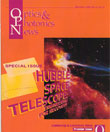
November 1993 Issue
Feature Articles
Hubble Space Telescope: Restoring the Image
Launched in April 1990, the Hubble Space Telescope (HST) is now in routine operation, "chalking up" a succession of scientific accomplishments despite a number of technical challenges. Some of HST's accomplishments to date include the tracking of a rare, giant storm on Saturn, the unexpected detection of numerous clouds of hydrogen gas near our galaxy, the discovery of a stellar "fountain of youth" in 47 Tucanae, finding increased evidence of the existence of "black holes" in the core of galaxies such as NGC 4261, and the exciting spectroscopy of Beta Pictoris.
by Joseph RothenbergDevelopment of the Second Generation Wide Field Planetary Camera for HST
With the launch of Space Shuttle Endeavour early next month, the fate of NASA's Hubble Space Telescope will rest in the skilled hands of five experienced astronauts whose demanding tasks will include installing corrective optics made necessary by the telescope's precisely polished, but tragically flawed, 2.4 m diameter main mirror. The corrective optics for the telescope's centrally located instrument, the Wide Field Planetary Camera (WFPC), are incorporated in an entirely new version of the 280 kg (618 lb.) instrument. Like its perfectly-functioning predecessor, WFPC II will re-image the focal plane of the telescope onto large-format electronic detector arrays through a selection of 48 spectral filters ranging from far-ultraviolet to near-infrared wavelengths, and will offer a choice of two magnifications. The second generation instrument was already under construction as a backup when the telescope was launched in 1990.
by Arthur H. Vaughan and David H. RodgersAt NASA's request, Riccardo Giacconi, Director of the Space Telescope Science Institute, convened a panel of experts in the summer of 1990 to identify and assess strategies for recovering the HST's capabilities degraded by spherical aberration. This panel included astronomers, optical scientists, astronauts, and engineers from industry, academia, and government. The European Space Agency (ESA)—a partner with NASA in the HST program—contributed significant expertise in optics and space astronomy. The Strategy Panel studied the problem and developed and evaluated solutions during the late summer and fall of 1990 during a series of meetings in the U.S. and Europe. The panel concluded the optical problem was well enough understood to design highly effective optical correctors. After investigating numerous solutions, it was decided that corrective mirrors with precisely the same amount of spherical aberration as the HST's primary mirror, but with the opposite mathematical sign, would pose the best approach.
by James H. CrockerOptical Testing and Verification on HST
The formal investigation of the Hubble Space Telescope (HST) imaging problem involved reconstructing the events that occurred from 1978-1981 during manufacture (build), assembly, and testing phases of the HST primary mirror. The optical error in the HST brought the role of quality assurance (QA) into question, since the problem remained undiscovered before launch. From an examination of the evidence, it was clear that there were specific QA requirements in the contract for building the Optical Telescope Assembly (OTA) and that an "OTA Product Assurance Plan" was written and released.
by Mark A. KahanPolarization Experiments with Light Waves
I recently became intrigued with the idea that although it's fun to show young people many of the fascinating things that light does, it might also be quite interesting and challenging to demonstrate what light is, as opposed to what it does. The September "Light Touch" was the first of two articles dealing with this subject. This is the second.
by Janet ShieldsStandardizing Interferometric Measurement
Because the U.S. supplies much of the interferometric measurement hardware and software used these days, the ANSI/NAPM IT.11 Subcommittee on Interferometric Testing has been asked to take the lead in formulating standards for interferometric measurement of wavefront error and surface roughness. As OPN went to press, the committee was scheduled to discuss several related isssues at the OSA Annual Meeting Oct. 3-8 in Toronto. One item the committee is considering is the rather mundane question of how to define "peak-to-valley" error. The widely used but naive answer is the lowest valley subtracted from the highest peak. A little thought shows that finding these two extremes depends on the spatial sampling density and the alignment of the sampling grid with the surface in question.
by Robert Parks

![Manual probe system with needles for test of semiconductor on silicon wafer. [A. Morozov / Getty]](https://opnmedia.blob.core.windows.net/$web/opn/media/images/articles/2025/1125/departments/202511-cover-web.jpg?ext=.jpg)
![Researcher Clara Saraceno in the lab. [Image by Carsten Behler Photography]](https://opnmedia.blob.core.windows.net/$web/opn/media/images/articles/2025/1025/departments/202510-cover-web.jpg?ext=.jpg)
